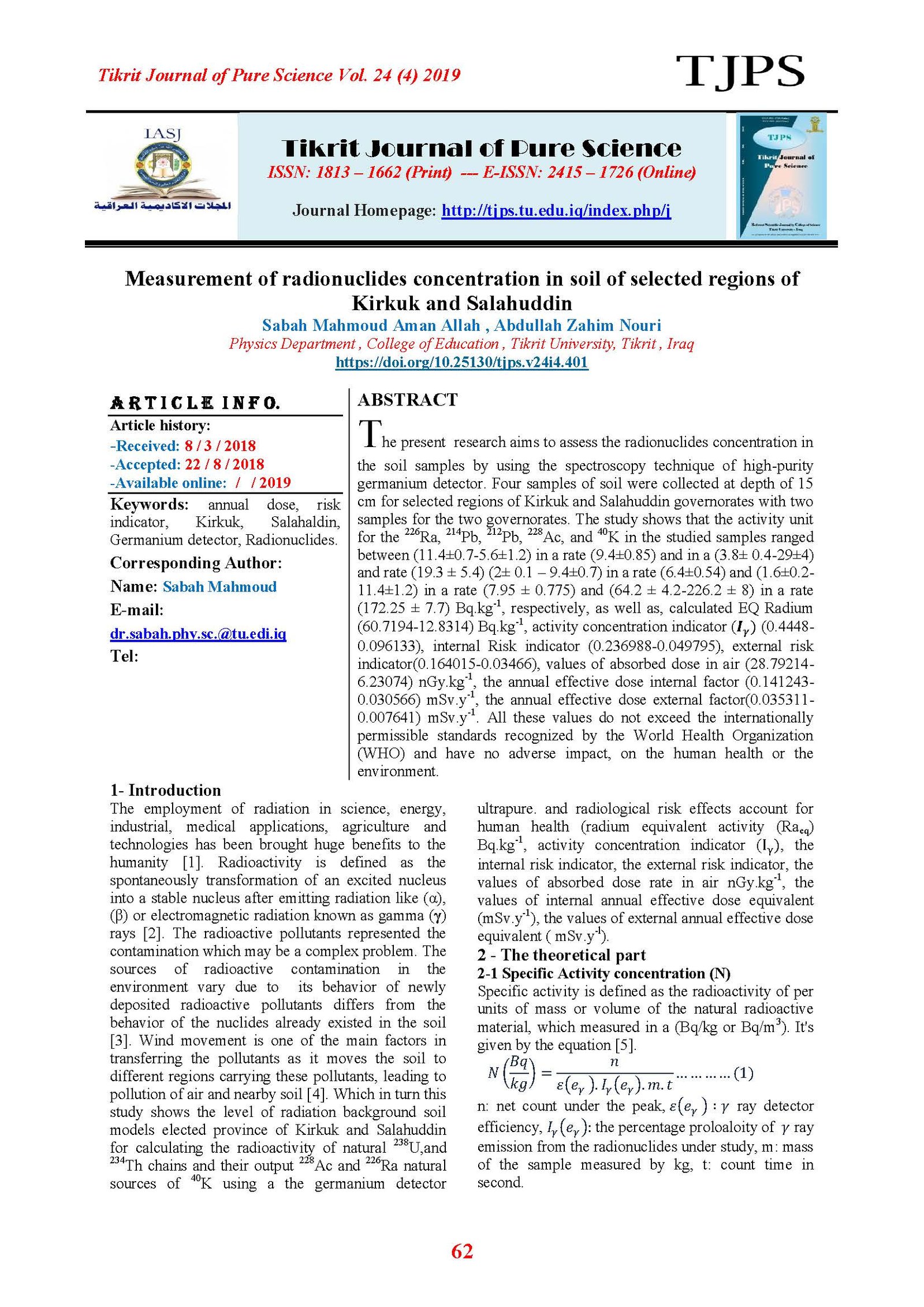Measurement of radionuclides concentration in soil of selected regions of Kirkuk and Salahuddin
Main Article Content
Abstract
The present research aims to assess the radionuclides concentration in the soil samples by using the spectroscopy technique of high-purity germanium detector. Four samples of soil were collected at depth of 15 cm for selected regions of Kirkuk and Salahuddin governorates with two samples for the two governorates. The study shows that the activity unit for the 226Ra, 214Pb, 212Pb, 228Ac, and 40K in the studied samples ranged between (11.4±0.7-5.6±1.2) in a rate (9.4±0.85) and in a (3.8± 0.4-29±4) and rate (19.3 ± 5.4) (2± 0.1 – 9.4±0.7) in a rate (6.4±0.54) and (1.6±0.2-11.4±1.2) in a rate (7.95 ± 0.775) and (64.2 ± 4.2-226.2 ± 8) in a rate (172.25 ± 7.7) Bq.kg-1, respectively, as well as, calculated EQ Radium (60.7194-12.8314) Bq.kg-1, activity concentration indicator ( (0.4448-0.096133), internal Risk indicator (0.236988-0.049795), external risk indicator(0.164015-0.03466), values of absorbed dose in air (28.79214-6.23074) nGy.kg-1, the annual effective dose internal factor (0.141243-0.030566) mSv.y-1, the annual effective dose external factor(0.035311-0.007641) mSv.y-1. All these values do not exceed the internationally permissible standards recognized by the World Health Organization (WHO) and have no adverse impact, on the human health or the environment.
Article Details

This work is licensed under a Creative Commons Attribution 4.0 International License.
Tikrit Journal of Pure Science is licensed under the Creative Commons Attribution 4.0 International License, which allows users to copy, create extracts, abstracts, and new works from the article, alter and revise the article, and make commercial use of the article (including reuse and/or resale of the article by commercial entities), provided the user gives appropriate credit (with a link to the formal publication through the relevant DOI), provides a link to the license, indicates if changes were made, and the licensor is not represented as endorsing the use made of the work. The authors hold the copyright for their published work on the Tikrit J. Pure Sci. website, while Tikrit J. Pure Sci. is responsible for appreciate citation of their work, which is released under CC-BY-4.0, enabling the unrestricted use, distribution, and reproduction of an article in any medium, provided that the original work is properly cited.
References
[1] Armin, A. (2010). Radiation Threats and your safety-1st edition", Chapman & Hall/CRC Taylor & Francis Group, USA, p.3.
[2] Michael, P. and Leo, M.L.N. (2007). Radionuclide Concentrations in Food and the Environment- 1st edn. CRC Press, USA, p.115.
[3] الحكيم، مؤيد محمد رشدي، ) 2001 (، مجلة الذرة والتنمية ،نشرة
فصلية ربع سنوية تصدرها الهيئة العربية للطاقة الذرية تونس، مجلد –
13 ، العدد 1، ص. 115 - 117 .
[4] Michael, G.S. (2007). Radiation Protection and Dosimetry-An Introduction to Health Physics, Springer Verlag, German, p.155.
[5] Tawfiq, N.F.; Mansour, H.L. and Karim, M.S. (2015). International Journal of Recent Research and Review. VIII(1):1-7.
[6] Ramola, R.C. et al.(2011). Current Science, 100(6):906-914.
[7] Ahmed, A. and Hussein, M.I. (2011). Engineering and Technology, World Academy of Science:74.
[8] Avwiri, G.O.; Osimobi, J.C. and Agbalagba, E.O. (2012). Journal of Environmental and Earth Sciences, 1(1):1-10.
[9] Hossain, M.K.; Hossain, S.M.; Azim, R. and Meaze, A.M., (2010). Journal of Environmental Protection (1):10-14.
[10] EL-Taher, A. and Makhluf, S. (2010). Indian Journal of Pure & Applied Physics, (48):697-702.
[11] Hussain, H.H.; Hussain, R.O.; Yousef, R.M. and Shamkhi, Q. (2010). Radio analytical and Nuclear Chemistry, (284):43–47.
[12] Veiga, R. et al. (2006). Rad Meas, (41):189-196.
[13] Mehra, R.; Singh, S. and Singh, K. (2009). Indian Journal of Physics, 83(7):1031-1037.
[14] Knoll, G. (1979). Radiation Detection and Measurement-1st edn. John Wiley, U.S.A. p.:124-143.
[15] Tennelec (1985). High – Purity Coxial Germanium Detector Systems, Health Physics 50(6).
[16] Cottens, E., (2016). In Proceeding of the Symposium on SRBII, Journee Radon, Royal, Society of Engineers and Industrials of Belgium, p.:126-131.
[17] United Nations Scientific Committee on the Effects of Atomic Radiation- General Assembly, (2000). 3(4):146.
